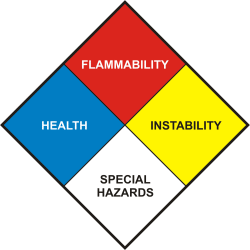NFPA 704 HAZARD DIAMOND
The U.S. National Fire Protection Association (NFPA) designed NFPA 704 as a standard system for the identification of the hazards of materials for emergency response. This standard presents a simple, readily recognized, and easily understood system of markings that provides criteria for assessing the health, flammability, instability, and related hazards that are presented by short-term, acute exposure to a material under conditions of fire, spill, or similar emergencies.
NFPA hazard diamond identifies the hazards of a material and the degree of severity of the health (blue), flammability (red), and instability (yellow) hazards. The white space at the bottom of the sign indicates special hazards. Hazard severity is indicated by a numerical rating that ranges from zero (0) indicating a minimal hazard, to four (4) indicating a severe hazard.
| HAZARD | HEALTH HAZARDS | FLAMMABILITY HAZARDS | INSTABILITY HAZARDS |
|---|---|---|---|
| 4 | Materials that, under emergency conditions, can be lethal. | Materials that rapidly or completely vaporize at atmospheric pressure and normal ambient temperature or that are readily dispersed in air and burn readily. | Materials that in themselves are readily capable of detonation or explosive decomposition or explosive reaction at normal temperatures and pressures. |
| 3 | Materials that, under emergency conditions, can cause serious or permanent injury. | Liquids and solids (including finely divided suspended solids) that can be ignited under almost all ambient temperature conditions. Materials in this degree produce hazardous atmospheres with air under almost all ambient temperatures or, though unaffected by ambient temperatures, are readily ignited under almost all conditions. | Materials that in themselves are capable of detonation or explosive decomposition or explosive reaction but that require a strong initiating source or must be heated under confinement before initiation. |
| 2 | Materials that, under emergency conditions, can cause temporary incapacitation or residual injury. | Materials that must be moderately heated or exposed to relatively high ambient temperatures before ignition can occur. Under normal conditions, these materials would not form hazardous atmospheres with air, but under high ambient temperatures or under moderate heating they could release vapor in sufficient quantities to produce hazardous atmospheres with air. Materials in this degree also include finely divided suspended solids that do not require heating before ignition can occur. | Materials that readily undergo violent chemical change at elevated temperatures and pressures. |
| 1 | Materials that, under emergency conditions, can cause significant irritation. | Materials that must be preheated before ignition can occur. Materials in this degree require considerable preheating, under all ambient temperature conditions, before ignition and combustion can occur. | Materials that in themselves are normally stable but that can become unstable at elevated temperatures and pressures. |
| 0 | Materials that, under emergency conditions, would offer no hazard beyond that of ordinary combustible materials. | Materials that will not burn under typical fire conditions, including intrinsically noncombustible materials such as concrete, stone, and sand. | Materials that in themselves are normally stable, even under fire conditions. |
| SPECIAL HAZARDS | |
|---|---|
| -–W | Materials that react violently or explosively with water |
| OX | Materials that possess oxidizing properties |
| SA | Materials that are simple asphyxiant gases: nitrogen, helium, neon, argon, krypton, and xenon. |
| Although NFPA 704 defines only these three special hazards, other self-explanatory symbols are sometimes used unofficially. | |
Bibliography:
- NFPA 704: Standard System for the Identification of the Hazards of Materials for Emergency Response. NFPA. 31 Aug. 2014. <http://www.nfpa.org/codes-and-standards/document-information-pages?mode=code&code=704>.
Citing this page:
Generalic, Eni. "NFPA 704 Hazard Diamond." EniG. Periodic Table of the Elements. KTF-Split, 13 Feb. 2025. Web. {Date of access}. <https://www.periodni.com/nfpa_704_diamond.html>.
Articles and tables
- Periodic table
- Online calculators
- Scientific calculator for chemists
- Gas laws calculator
- Molar mass calculator
- Angle converter
- Roman numerals converter
- Number systems converter
- Preparation of solutions
- Labeling of chemical containers
- Oxidation numbers calculator
- ARS method
- Oxidation number change method
- Ion-electron method
- Gauss elimination method
- Memory game
- Find the pairs
- Articles and tables
- Chemistry
- List of abbreviations and acronyms
- Crystal systems and Bravais lattices
- GHS - Hazard pictograms
- NFPA 704 Hazard Diamond
- Fundamental physical constants
- Solubility product constants
- SI - International System of Units
- Composition of mixtures and solutions
- Stoichiometric calculations
- Chlorinity and salinity of seawater
- Rare earth elements (REE)
- Ecology
- Web design
- Chemistry dictionary
- Chemistry
- Downloads
- ≡ Menu

